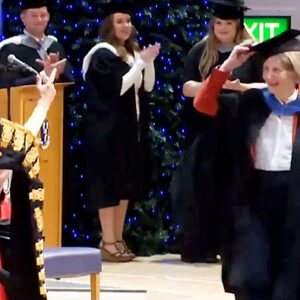
For some people, hearing and seeing are luxuries that they don’t possess, yet this doesn’t mean that they can’t communicate. In fact, there’s a special community in Washington State that have created their own human language known as pro-tactile ASL, which has gained recognition in recent years.
Reportedly birthed from the spirit of human connection, people that cannot see nor hear actually use another person’s body as their canvas, and there they communicate an innumerable amount of feelings, ideas, or just the usual speech that two or more people may have with one another.
While humans that speak verbally tend to use different kinds of additional sensory signals to help those with hearing or listening disabilities – like making hand gestures or faces – touching to communicate, especially on the face or thigh, is usually reserved for those with incredibly close human connections.
For those speaking in American Sign Language, or ASL, it can be weird to see “the literalness” of certain signs come to life. For example, while the speaker may be saying the word “jolly” as a way to describe someone’s waist size – like with Santa Claus – ASL doesn’t have that luxury and normally have to call the word they are signing as the actual word.
But when it comes to people that cannot hear nor see, language is even more ‘stripped of its societal layers,’ becoming even way more human.
According to Katherina Ellen Foley, who wrote an article in Quartz, she shared that during a first-hand encounter with a DeafBlind American, she shared how the gentleman using pro-tactile ASL shared through an ASL interpreter that “it’s the same concept as learning any other language, it’s just connecting with the group of people whose language you want to learn.”
Foley gave the example, “I climb a tree” where the singer takes someone’s arm and does the sign for walking up the arm as if the arm was a tree. When it comes to “lollipop,” it’s almost the same, except that the signer uses a closed fist for the candy portion. Although this may seem hard to interpret, a deaf ASL interpreter shared that “context is key” in all languages.
Notably, while a closed fist at the end of a forearm could mean a number of things, such as a hammer or a lollipop or many others, but the it’s the context of the actual sentence that will help both the speakers and signers to the correct inference. Much like the English language, people can detect certain words that are used depending on the focus of the sentence, such as “fair” or “fare” or “bear” or “bare.”
In America, the possible number of people that are blind and deaf is around 50,000, and this new type of language is becoming increasingly popular. Tactile Communications happens to be the business that provides the needed training in a culturally and linguistically appropriate setting in order to properly promote the autonomy of the DeafBlind community. And back in 2016, this special language which grew within their own group, was even showcased in the White House.
It’s important to understand that communication is not defined simply by a domain of words and mouth sounds, but it’s a way of understanding between individuals. By going back to this core principle was what pushed this pro-tactile system to grow.
An article in OPB shared that Tactile Communications founder, Jelica Nuccio, ‘set up communication environments without the crutch of interpreters to help ensure the skill was born of a symbiosis between necessity and invention.’ Incredibly, it has been making a very big difference in the lives of those all around the country.
To see more about this story, take a look at the video below.
What are your thoughts? Please comment below and share this news!
True Activist / Report a typo


